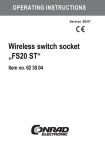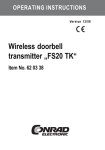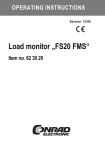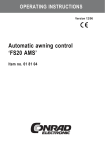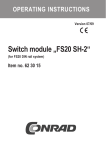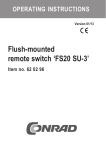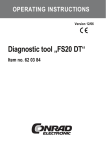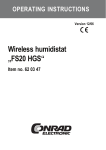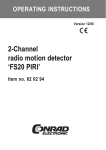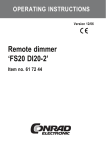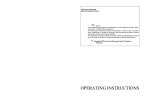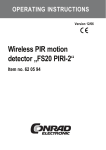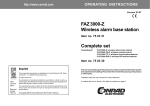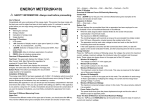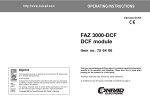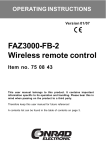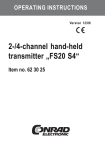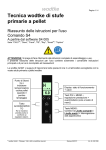Download Wireless switch socket „FS20 ST-3“
Transcript
OPERATING INSTRUCTIONS Version 05/09 Wireless switch socket „FS20 ST-3“ Item no. 62 30 04 Introduction Dear customer, Thank you for purchasing this product. This product meets the requirements of both current national and European guidelines. Please read the user manual completely and observe the safety and operation instructions before using the product! This user manual belongs to this product. It contains important information specific to its operation and handling. Please bear this in mind when passing on the product to a third party. Therefore keep this user manual for future reference! All company and product names contained herein are trademarks of their respective owners. All rights reserved. For more inquiries, contact or consult our technical service: Germany: 2 Tel. no.: +49 9604 / 40 88 80 Fax. no.: +49 9604 / 40 88 48 e-mail: [email protected] Mon. to Thur. 8.00am to 4.30pm Fri. 8.00am to 2.00pm Table of contents Page 1. 2. 3. 4. 5. 6. 7. 8. 9. 10. 11. 12. 13. 14. 15. 16. Prescribed use ................................................................................. 4 Scope of delivery ............................................................................. 4 Explanation of icons ......................................................................... 5 Safety instructions ........................................................................... 5 Control panel .................................................................................... 7 Registering a FS20 transmitter ....................................................... 8 Operation .......................................................................................... 9 a) Remote control operation .......................................................... 9 b) Controlling the FS20 device ...................................................... 9 c) Direct operation ......................................................................... 9 Timer function ................................................................................ 10 a) Programming the timer ............................................................ 10 b) Timer operation ........................................................................ 11 Starting the timer ..................................................................... 11 Prematurely stopping the timer ............................................... 11 Deactivating timer function ..................................................... 11 Deactivating/activating the programmed timer ...................... 12 Integrating the wireless switch socket into the FS20 address system .................................................................... 13 a) Assigning further addresses/address types .......................... 13 b) Deleting addresses and address types .................................. 13 Resetting the default settings ........................................................ 14 Handling ......................................................................................... 15 Maintenance and cleaning ............................................................ 16 Disposal .......................................................................................... 16 Information on the range ............................................................... 17 Declaration of conformity (DOC) .................................................. 19 Technical specifications and features .......................................... 19 3 1. Prescribed use The wireless switch socket ‘FS20 ST-3’ functions exclusively in conjunction with the FS20 wireless control system. The wireless control system can switch a device that is connected to the wireless switch socket on or off or dim the device without the use of cables (refer to technical specifications and features). Another feature is the integrated programmable timer function. No part of the product may be modified or adapted and the casing must not be opened. The safety instructions and installation notes in this user manual must be observed without fail. Any use other than the one described above may damage the product and can also possibly create additional dangers, for example, short-circuit, fire, electrical shock, etc. Read these operating instructions thoroughly and carefully, as they contain a great deal of important information for the operation and handling. 2. Scope of delivery • Wireless switch socket ‘FS20 ST-3’ • User manual 4 3. Explanation of icons The icon with a lightning flash in a triangle is used to alert you to potential personal injury hazards such as electric shock. The icon with an exclamation mark in a triangle points to important instructions in this user manual that must be observed. The ‘hand’ symbol indicates special tips and information on operation. 4. Safety instructions The product’s guarantee becomes invalid if the product is damaged as a result of failure to observe these operating instructions. We do not assume any liability for any resulting damages! Nor do we assume liability for damage to property or personal injury caused by improper use or failure to observe the safety instructions. In such cases the product’s guarantee becomes invalid! • For safety and licensing (CE) reasons any unauthorised alterations to and/or modification of the product are not permitted. • Do not use this product in hospitals or medical institutions. Although the product emits only relatively weak radio signals, these may cause lifesupport systems to malfunction. This may also be the case in other areas. 5 • The product is designed in accordance with protection class I. The only voltage source that may be used is that of the correct power socket-outlet (230V~/50Hz) with the protective earth conductor of the public power supply system. • The product is not a toy and should be kept out of the reach of children. Therefore take particular care when children are around! • Make sure the product does not become damp or wet; it is only suitable for use in dry indoor locations (not bathrooms or similar). Otherwise there is the risk of a life-threatening electric shock! • Protect the product against heat, cold, and direct sunlight while in storage or operation. • Never dismantle the product! There is danger of a fatal electric shock! • Do not leave packaging material lying around. This may become a dangerous plaything in the hands of children. • The accident-prevention regulations, established by the Employer’s Liability Insurance Association for electrical equipment and facilities, must be adhered to in commercial facilities. • Consult a skilled technician if you have doubts about the mode of operation, safety or connection of the device. • Handle the product with care; knocks, blows or even a fall from a low height can damage it. 6 5. Control panel Socket for consumer loads (230V~/50Hz, max. 16A/3680W) Control keys with integrated LED On the back side there is a shock-proof plug that must be plugged into a socket of the public power supply system (230V~/50Hz). Quick function test • Plug the ‘FS20 ST-3’ into a power socket with an earth connector (operating voltage 230V~/50Hz). • For example, using a lamp as a load, plug it into the socket on the front side of the wireless switch socket. • Briefly press the control button on the wireless switch socket. It should be possible to switch the load (for example, the lamp) on and off by briefly pressing the button (1. ‘on’, 2. ‘off’, 3. ‘on’, etc.). 7 6. Registering a FS20 transmitter To register the wireless switch socket ‘FS20 ST-3’ with a FS20 transmitter (for example, a remote control from the FS20 wireless control system or other devices, such as the load monitor ‘FS20 FMS’), proceed as follows: • Press and hold the control button on the ‘FS20 ST-3’ for at least 5 seconds. The control indicator/LED on the wireless switch socket starts to blink and the device is now in programming mode. Alternatively, the wireless switch socket can also be plugged into the socket with the control button already pressed. This way the device switches immediately to programming mode (control indicator/LED blinks). • Briefly press a button of the desired key combination on your remote control or corresponding control button of a FS20 device (for example, load monitor ‘FS20 FMS’). When the wireless switch socket receives the code the control indicator/ LED stops blinking. The wireless switch socket is now programmed to this remote control or the corresponding FS20 device. • If required, the programming can be replaced at any time by another button on the remote control, or by another remote control channel. To do this, proceed again as described above. 8 Additional functions (for example, timer programming) are described later in this user manual. 7. Operation a) Remote control operation Switching on: Briefly press the right button of the programmed button combination Switching off: Briefly press the left button of the programmed button combination b) Controlling the FS20 device The procedure varies, depending upon the FS20 device. Please refer to the user manual of the specific FS20 device. For example, the load monitor ‘FS20 FMS’: Switching on: Briefly press the control key on the ‘FS20 FMS’ Switching off: Briefly press the control key on the ‘FS20 FMS’ c) Direct operation Switching on: Briefly press the control key on the wireless switch socket Switching off: Briefly press the control key on the wireless switch socket The switch alternates every time the control key is pressed (‘toggle’ function). When the wireless switch socket is switched on, pressing the button will switch it off (and vice versa). 9 8. Timer function The wireless switch socket can also be used as a timer. As soon as a switching time has been programmed, the ‘FS20 ST-3’ remains switched on for the programmed length of time after each power-on command. After this time has expired, it automatically switches off. The timer is programmable for an on-time of between 1 second and 270 minutes (4 hours 30 min). In order to program the timers you require a remote control from the FS20 wireless control system. Please refer to the corresponding user manual. It is possible to program the timer for the load monitor ‘FS20 MS’ with its command menu; the following section does not apply to the ‘FS20 FMS’. a) Programming the timer • Simultaneously press and hold both buttons of the respective button combination on your FS20 remote control for one to three seconds (1 to 3 sec). • The control indicator/LED on the wireless switch socket blinks. The time measurement for the desired on-time begins. • After the desired amount of time has expired press both buttons on the remote control again simultaneously for one to three seconds (1 to 3 sec). The on-time is now programmed. 10 Please note: If the time measurement is not ended manually, the timer programming mode will automatically be ended after 270 minutes (4 hours 30min). The timer is then programmed for a on-time of 270 minutes (4 hours 30min). b) Timer operation X Starting the timer There are two different ways of doing this: • Briefly press the control button on the wireless switch socket. or: • Briefly press the right button of the assigned button combination on your remote control. X Prematurely stopping the timer Naturally, the wireless switch socket and connected consumer loads are able to be switched-off manually at any time. There are two different ways of doing this: • Briefly press the control button on the wireless switch socket. or: • Briefly press the left button of the assigned button combination on the remote control. X Deactivating timer function • Press and hold the respective button combination on the remote control of your wireless switch socket simultaneously for one to three seconds (1 to 3 sec). • The control indicator/LED on the wireless switch socket blinks. 11 • Now briefly press the control button on the wireless switch socket. The timer programming mode is ended and the timer function is removed. You can now use the wireless switch socket again in its normal manual operation mode. X Deactivating/activating the programmed timer If you do not wish to use the timer temporarily but intend to keep the programmed time, the timer can be deactivated. This puts the remote switch in normal manual switching mode. When needed, the timer can be used again without re-programming the time. Deactivating the timer: • Hold down the pair of buttons on your remote control assigned to the remote switch for 1 to 3 seconds simultaneously. • The control indicator/LED on the wireless switch socket blinks. • Hold down the left button of the pair of buttons assigned on your remote control for more than 0.4 seconds (but less than 3 seconds!). • Now the remote switch can be switched manually. The timer is deactivated. Re-activating the timer: • Hold down the pair of buttons on your remote control assigned to the remote switch for 1 to 3 seconds simultaneously. • The control indicator/LED on the wireless switch socket blinks. • Hold down the right button of the pair of buttons assigned on your remote control for more than 0.4 seconds (but less than 3 seconds!). Now the timer is activated again and can be started when switched on the next time. 12 9. Integrating the wireless switch socket into the FS20 address system The ‘FS20 ST-3’ wireless switch socket can be integrated into the address system of the FS20 wireless control system via the latter’s addressing scheme using single addresses, function groups, local and global masters. More detailed information on exactly how this address system is structured is provided in the user manual of each transmitter belonging to the FS20 wireless control system. a) Assigning further addresses/address types The wireless switch socket can assign up to four address types within the address system of the FS20 wireless control system. This makes it possible, for example, to operate the wireless switch socket remotely from several transmitters with the same or different address types. You can find more detailed information on the address system in the user manual of each remote control belonging to the FS20 wireless control system. To assign several address types to the wireless switch socket, repeat the programming steps described in section 6. You can create a list of up to four addresses or address types in the switch socket’s memory. b) Deleting addresses or address types To delete a reception channel from the saved list, proceed as follows: • Place the ‘FS20 ST-3’ in programming mode as described in section 6 (press and hold the control button on the ‘FS20 ST-3’ for at least 5 seconds, until the control indicator/LED begins to blink). 13 • Now press and hold (for at least 0.4 seconds) your remote control button that has been assigned to the reception channel that you wish to delete. • Afterwards the programming mode is automatically ended and the corresponding channel is deleted from the address list of the wireless switch socket. 10. Resetting the default settings If necessary, you can delete in one step all programs and settings that were previously saved in the wireless switch socket, thus setting the switch socket back to its delivery state with all default settings. To do so, proceed as follows: • Press and hold the control button on the wireless switch socket for at least 5 seconds. • The control indicator/LED on the wireless switch socket starts to blink and the device is now in programming mode. Then release the button. • Briefly press the control button again. All assigned addresses and the timer mode with its programmed timer setting are now deleted or deactivated. • The control indicator/LED goes out and the programming mode is ended. 14 The wireless switch socket no longer responds to any remote command and must be programmed again! 11. Handling The product should only be used in dry indoor areas. The following unfavourable conditions at the installation site, during operation or transport are to be avoided: - Moisture or excessive air humidity - Extreme cold or heat - Direct sunlight - Dust or flammable gases, vapours or solvents - Strong vibrations - Strong magnetic fields such as those found near machines or loudspeakers Never use the product immediately after it has been brought from a cold room into a warm one. The condensation water generated could destroy the product. Wait until the product has reached room temperature. This can take several hours. Do not handle the product with damp or wet hands! This is true for all electrical devices! The device must not be opened or taken apart. There are no serviceable parts inside the product. The licence (CE) and the guarantee/warrantee becomes invalid if you open/take apart the device. Make sure that the insulation of the entire product is neither damaged nor destroyed. Always check the product for damage before using it! If you detect any damage, do NOT connect the product to the supply voltage! Life-threatening danger! 15 This product is not a toy and should be kept out of the reach of children. Even a fall from a low height can damage the product. 12. Maintenance and cleaning This product does not require maintenance. Repairs or maintenance work may only be carried out by a skilled technician! Before cleaning, unplug the ‘FS20 ST-3’ from the power supply and remove any cables or devices that are currently attached to the ‘FS20 ST-3’. Then clean the ‘FS20 ST-3’ using a soft, clean, dry and lint-free cloth. To remove heavier dirt, use a cloth which is slightly moistened with lukewarm water. Never use solvent-based cleaning agents, as these may damage the surface of the plastic casing and its inscription. Afterwards allow the ‘FS20 ST-3’ to dry completely before plugging it back into the power supply socket. 13. Disposal When the product is no longer usable, dispose of it in accordance with the applicable statutory regulations. 16 14. Information on the range • The FS20 wireless control system, including the ‘FS20 ST-3’, works in the 868MHz range. This range is also used by other devices and radio services. Therefore devices that operate on the same or neighbouring frequency may restrict both the operation of the ‘FS20 ST-3’ and its range. • The specified range of up to 100m is the so-called free-field range. This describes the range when there is direct visual contact between the transmitter and the receiver. In practice, however, walls, ceilings, etc. between the transmitter and the receiver may affect and reduce the range. Other causes of reduced ranges: • All types of high-frequency interference • Any buildings or vegetation • Conductive metal parts that are located near the devices or within or near their transmission path, for example, radiators, metallised insulation glass windows, reinforced concrete ceilings, etc. • Influence on the radiation pattern of antennas due to the distance from the transmitter or receiver to conductive surfaces or objects (also to human bodies or the ground) • Broadband interference in urban areas that reduces the signal-to-noise ratio; the signal is no longer recognised due to this ‘noise’ • Interference radiation resulting from insufficiently shielded electronic devices, for example, operating computers or similar 17 Please note: Do not place several wireless receivers (for example switch sockets) directly next to each other, because they can negatively affect each other (range may be reduced!). Keep them separated by a distance of at least 20cm. 18 15. Declaration of conformity (DOC) We, Conrad Electronic, Klaus-Conrad-Straße 1, D-92240 Hirschau (Germany), hereby declare that this product complies with the fundamental requirements and other relevant regulations of directive 1999/5/EG. You can find the declaration of conformity for this product at www.conrad.com. 16. Technical specifications and features Power supply: ............................. 230V~/50Hz Power consumption: ................... approx. 0,5W Breaking capacity: ...................... 3680W (230V~/16A) Programmable timer settings: ... 1 second to 270min (4 hours 30min) Frequency: .................................. 868.35MHz Modulation: ................................. AM Range: ......................................... up to 100m (free-field) Dimensions (W x H x D): ........... 56mm x 134mm x 39mm (without plug) Memory conservation also without power supply (for instance, during a power outage). 19 http://www.conrad.com CONRAD IM INTERNET http://www.conrad.com Legal Notice These operating instructions are a publication by Conrad Electronic SE, KlausConrad-Str. 1, D-92240 Hirschau (www.conrad.com). All rights including translation reserved. Reproduction by any method, e.g. photocopy, microfilming, or the capture in electronic data processing systems require the prior written approval by the editor. Reprinting, also in part, is prohibited. These operating instructions represent the technical status at the time of printing. Changes in technology and equipment reserved. © Copyright 2009 by Conrad Electronic SE. 04_0509_01




















